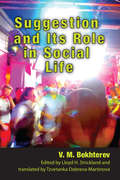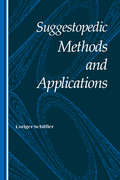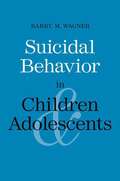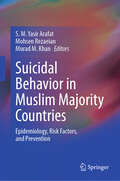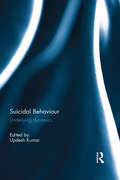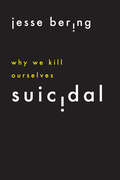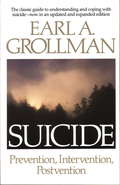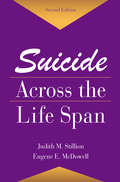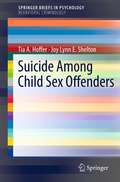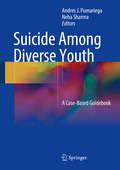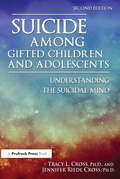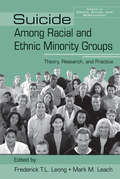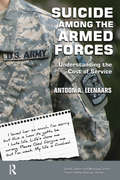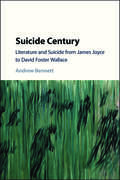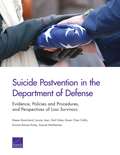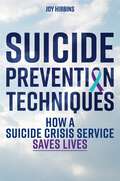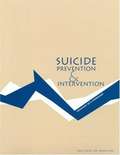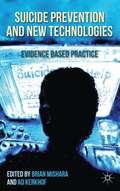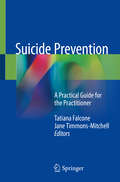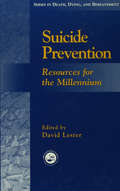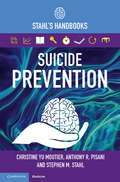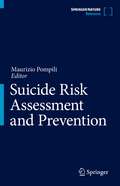- Table View
- List View
Suggestibility in Legal Contexts
by Fiona Gabbert David J. La Rooy Anne M. RidleyA comprehensive survey of the theory, research and forensic implications related to suggestibility in legal contexts that includes the latest research.Provides a useful digest for academics and a trusted text for students of forensic and applied psychologyA vital resource for legal practitioners who need to familiarize themselves with the subjectIncludes practical suggestions for minimizing witness suggestibility in interviewsFeatures topics that focus on suggestibility at each stage - from witnessing a crime through to trial
Suggestible You: The Curious Science of Your Brain's Ability to Deceive, Transform, and Heal
by Erik VanceThis riveting narrative explores the world of placebos, hypnosis, false memories, and neurology to reveal the groundbreaking science of our suggestible minds. Could the secrets to personal health lie within our own brains? Journalist Erik Vance explores the surprising ways our expectations and beliefs influence our bodily responses to pain, disease, and everyday events. Drawing on centuries of research and interviews with leading experts in the field, Vance takes us on a fascinating adventure from Harvard's research labs to a witch doctor's office in Catemaco, Mexico, to an alternative medicine school near Beijing (often called "China's Hogwarts"). Vance's firsthand dispatches will change the way you think--and feel. Expectations, beliefs, and self-deception can actively change our bodies and minds. Vance builds a case for our "internal pharmacy"--the very real chemical reactions our brains produce when we think we are experiencing pain or healing, actual or perceived. Supporting this idea is centuries of placebo research in a range of forms, from sugar pills to shock waves; studies of alternative medicine techniques heralded and condemned in different parts of the world (think crystals and chakras); and most recently, major advances in brain mapping technology. Thanks to this technology, we're learning how we might leverage our suggestibility (or lack thereof) for personalized medicine, and Vance brings us to the front lines of such study.
Suggestion and Autosuggestion: A Psychological and Pedagogical Study Based Upon the Investigations Made by the New Nancy School (Collected Works of Charles Baudouin)
by Charles BaudouinThis title, originally published in 1920, second edition in 1924, has been largely forgotten in the history of hypnosis. Charles Baudouin’s first book, it is an important account of the early theories of the New Nancy School, widely recognised as the founding school of modern day hypnosis. The author provides a detailed discussion of autosuggestion, as well as providing some practical suggestions.
Suggestion and its Role in Social Life
by V. M. BekhterevVladimir Mikhailovitch Bekhterev was a pioneering Russian neurologist, psychiatrist, and psychologist. A highly esteemed rival of Ivan Pavlov, his achievements in the areas of personality, clinical psychology, and political and social psychology were recognized and acclaimed throughout the world. However, when his version of reflexological doctrine ran afoul of official Soviet ideology in the 1920s his work was banned and his influence suppressed through the dispersal of his many colleagues and disciples. Bekhterev himself died in 1927 under mysterious circumstances. This translation of Suggestion and Its Role in Social Life is a significant instance of intellectual and cultural restoration. It marks a starting point of Bekhterev's lifelong endeavor to relate his clinical observations and philosophy of science to problems of the social world.Bekhterev's investigation reviews and explains the many conflicting positions in the social and scientific thought concerning the nature and power of suggestion. He takes pains to differentiate the process from persuasion and hypnosis, and discusses suggestion and autosuggestion in the waking state, examining their effectiveness on feeling, thought, and behavior. He then discusses the destructive consequences of the process—violent crime, suicide, witchcraft, and devil-possession hysteria— in a wide variety of contexts important in the Russia, Europe and North America of the period.Bekhterev presents a structural model of the mind, including both conscious and unconscious realms, and the phenomena of suggestion without awareness; in doing so he anticipated much present-day work on preconscious influence. Suggestion and Its Role in Social Life is a landmark study in collective psychological research that may lead to revisions in histories of social psychology. It will be read by psychologists, sociologists, and social historians.
Suggestopedic Methods/Applicat
by SchifflerFirst Published in 1992. Routledge is an imprint of Taylor & Francis, an informa company.
Suicidal Behavior in Children and Adolescents
by Barry M. WagnerIn this remarkably clear and readable evaluation of the research on this topic, Barry Wagner presents the current state of knowledge about suicidal behaviors in children and adolescents, addressing the trends of the past ten years and evaluating available treatment approaches. Wagner provides an in-depth examination of the problem of suicidal behavior within the context of child and adolescent behavior. Among the developmental issues covered are the evolving capacity for emotional self-regulation, change and stresses in family, peer, and romantic relationships, and developing conceptions of time and death. He also provides an up-to-date review of the controversy surrounding the possible influence of antidepressant medications on suicidal behavior. Within the context of an integrative model of the suicide crisis, Wagner discusses issues pertaining to assessment, treatment, and prevention.
Suicidal Behavior in Muslim Majority Countries: Epidemiology, Risk Factors, and Prevention
by S. M. Yasir Arafat Murad M. Khan Mohsen RezaeianThe book is about suicidal behavior in Muslim majority countries. Islam is the second-largest religion in the world. There are also sizable Muslim populations in non-Islamic countries. Suicide is strongly prohibited in Islam and based on this tenet, suicide and self-harm remain criminalized acts in many Islamic countries. When compared to the global estimates for suicide rates and to non-Islamic countries, Muslim majority countries have lower rates, indicating that Islamic faith and practice may be protective against suicidal behaviors. However, several factors such as criminal status, stigma toward suicide, extreme dearth of research, low-quality data, and under-reporting make it difficult to draw any firm conclusions. Hence, this book aims to do a deeper study of suicidal behaviors in Muslim majority countries, covering epidemiology, risk factors, and the challenges of suicide prevention in Muslim majority countries.
Suicidal Behaviour: Underlying dynamics
by Updesh KumarSuicidal Behaviour: Underlying dynamics is a wide ranging collection of articles that builds upon an earlier volume by the same editor (Suicidal Behaviour: Assessment of people-at-risk, 2010) and delves deeper into the dynamics of suicide by synthesizing significant psychological and interdisciplinary perspectives. The volume brings together varied conceptualizations by scholars across disciplines from around the globe, thereby adding on to the available theoretical understandings as well as providing research based inputs for practitioners in the field of suicidal behaviour. This book contains sixteen chapters divided into two broad sections. The volume opens with a discussion about the Theoretical Underpinnings of suicidal behaviour spread through the initial eight chapters that conceptualize the phenomenon from different vantage points of genetics, personality theory, cognitive and affective processes, stress and assessment theories. The second section brings in the Varied Research Evidences and Assessment Perspectives from different populations and groups. Building upon the theoretical foundations the chapters in this section discuss the nuances of dealing with suicidal behaviours among sexual minority populations, alcoholics, military personnel, and within in specific socio-cultural groups. The section closes with an intense focus on a significant issue encountered often in clinical practice, that of assessment of suicide risk, and ways of resolving the cultural, ethical and legal dilemmas.
Suicidal: Why We Kill Ourselves
by Jesse BeringThis personal inquiry into the psychology of suicide brings “compassion, confessional honesty, and academic perception” to a woefully misunderstood subject (Kirkus Reviews).Despite his success as a psychologist and writer, Jesse Bering spent most of his thirties believing he would probably kill himself. At times, the impulse to take his own life felt all but inescapable. When his suicidal thoughts began to fade, he felt relieved—but also curious. He wondered where they came from and if they would return; whether other animals experienced the same impulse, or if it was a uniquely human evolutionary development. In Suicidal, Bering answers all these questions and more.Drawing on personal stories, scientific studies, and remarkable cross-species comparisons, Bering explores the science and psychology of suicide. Revealing its cognitive secrets and the subtle tricks our minds can play on us, Bering helps readers analyze their own doomsday thoughts while gaining broad insight into the subject. Authoritative, accessible, personal, and profound, Suicidal will change the way you think about this most vexing of human problems.
Suicide
by Earl A. GrollmanProvides information on suicide statistics and gives advice on how to recognize the warning signs of a potential suicide attempt, how to intervene when a suicide has been attempted, and how to comfort families and friends who have lost a loved one to suicide. This updated and expanded edition contains a discussion of euthanasia and living wills and a list of crisis centers around the United States.From the Trade Paperback edition.
Suicide Across The Life Span: Premature Exits (Death, Education, Aging and Health Care)
by Judith M. Stillion Eugene E. McDowellFirst published in 1996. The complexities of suicide are examined from the developmental viewpoint. The text includes appropriate case studies, and three research studies, which were conducted especially for this work.
Suicide Among Child Sex Offenders
by Joy Lynn Shelton Tia A. HofferBy providing empirical data and multidisciplinary considerations, the book increases awareness of child sex offender suicide among the various entities which come into contact with this population of offenders. This book attempts to bring awareness of this potentially high risk population to better inform the law enforcement, corrections, and mental health communities of the unique risk factors for suicide among CSOs and provide a more effective crisis response. The Federal Bureau of Investigation (FBI) Behavioral Analysis Unit III- Crimes Against Children reviewed and analyzed 106 male Child Sex Offenders (CSO) who committed suicide during the course of a child sex crime investigation. Of the 106 CSOs, 79% were child pornography traders/collectors, 43% were child molesters, 21% were travelers, and 18% were child pornography producers. Analyses also revealed that nearly all were Caucasian and the majority were married, employed, and died via self-inflicted gunshot wound. Of particular interest was that in 26% of the cases, the offender killed himself within 48 hours of his awareness of the investigation; and in nearly half of the known cases, the offender had past/current military service and a criminal history. In addition, 68% left a suicide note, which is substantially higher than the general suicide population. Analysis of the notes revealed common aspects and themes including cognitive distortions, burdensomeness, shame, and self-blame. The most frequently cited reason for the suicide in the note was the child sex crime investigation.
Suicide Among Diverse Youth
by Neha Sharma Andres J PumariegaThis book provides a comprehensive review of the complex, growing mental health challenges faced by culturally diverse populations of children and adolescents. Suicide Among Diverse Youth: A Case-Based Guidebook is the first book of its kind, and is designed specifically to bridge the knowledge and skills gap encountered by most clinicians dealing with youth from diverse cultural backgrounds, particularly those different than that of the clinician. The title begins with two introductory chapters, which cover cultural aspects of suicidality among youth, culturally informed treatment of suicidality with diverse youth, and examples of preventative approaches. These are followed by population specific chapters which cover a broad spectrum of diverse populations, including underserved ethnic and racial populations in the United States, LGBTQ youth, as well as various immigrant populations from Eastern European and Middle Eastern countries. These case-based chapters are structured in a cohesive, easy-to-read format that promotes ease of reference, beginning with a clinical case report, review of literature, unique characteristics and risk factors associated with suicidality, and evidence-based practice provided by the authors from their considerable experience. The authors are often from the same ethnic, racial, or cultural group that they discuss in their writings; providing experiential knowledge where scientific knowledge is lacking. Suicide Among Diverse Youth: A Case-Based Guidebook is a unique resource that offers the clinical material needed to treat diverse adolescent patients with sensitive, intersectional, and culturally-informed care, and will provide an indispensable resource for medical professionals working with, and caring for these patients.
Suicide Among Gifted Children and Adolescents: Understanding the Suicidal Mind
by Tracy L. Cross Jennifer Riedl CrossThe updated second edition of Suicide Among Gifted Children and Adolescents explores the suicidal behavior of students with gifts and talents. It provides the reader with a coherent picture of what suicidal behavior is; clarifies what is known and what is unknown about it; shares two major theories of suicide with explanatory power; and offers an emerging model of the suicidal behavior of students with gifts and talents. In addition, the book includes chapters offering insight into the lived experience of students with gifts and talents, and what we can do to prevent suicide among gifted students, including creating caring communities and specific counseling strategies. It also provides a list of resources available to help.
Suicide Among Racial and Ethnic Minority Groups: Theory, Research, and Practice (Series in Death, Dying, and Bereavement)
by Frederick Leong Mark LeachSuicide is increasingly understood and predicted as an intersection of biological, psychological, cognitive, and sociocultural factors. We have some basic knowledge of these factors and how they interact, but presently we know very little about how culture can play a role as a variable that influences suicide. Suicide Among Racial and Ethnic Minority Groups will go a long way towards filling that gap by pulling together cutting edge empirical research from general cultural diversity literature and applying it to suicide assessment, treatment, and prevention theory and practice. By looking outside of the limited cross-cultural studies done within suicidal populations, the contributors – all established experts in both multicultural counseling and suicidology – expand the available empirical literature base in order to provide a deeper look into how culture can act as an important catalyst in suicidal intentions. Following theoretical overviews, the text focuses on six broad ethic groups classified in the literature (African American, American Indian, Asian American, European American, Hawaiian & Pacific Islander, and Hispanic), with a main chapter devoted to each, relating each culture to suicide research, highlighting specific variables within the culture that can influence suicide, and presenting appropriate treatment considerations. A final section of the book consists of practical applications within specific settings (therapy, outreach, schools, psychiatric services) and prevention and training issues.
Suicide Among the Armed Forces: Understanding the Cost of Service (Death, Value and Meaning Series)
by Antoon A LeenaarsNot since the great military suicide epidemic of the American Civil War have we seen so many of our heroes, our soldiers and veterans, die by suicide. Why? War is violence. There is intent to cause death, or serious injury, or threat to the physical and psychological integrity of others. War stress is unforgiving. Suicide is an all too frequent response. Today, one member of the military dies by suicide every day. This is a new epidemic. This book addresses some tough questions: What do we know about suicides in the military? Are rates high? Or low? Is military suicide the same or different in the United States and Canada? Is military culture relevant? Do we know the causes, patterns, and associations? Is suicide among the armed forces similar to or different from suicide among civilians? Can it be altruistic? Through individual case studies and general/population approaches, we attempt to understand the cost of military service. It is especially through the personal stories of the great Civil War hero General Emory Upton, Admiral of the Navy Mike Boorda, and Hospital Corpsman Chris Purcell that we find answers. We learn there is a relative lack of understanding about military suicides, mainly due to the very complexity of suicide. The nature of suicide is not monolithic--it is multi-determined. Military service, we find, is a risk factor for suicide and suicidal behavior. Military veterans are twice as likely as civilians to die by suicide. Posttraumatic stress disorder (PTSD) and traumatic brain Injury (TBI) are especially noted to be huge risk factors, but so are other physical and psychological injuries. Sadly, the aftershocks of war include not only suicides but also incarceration, motor vehicle accidents, homicides, homicide(s)-suicides, and many more faces of violence. And there are many more, uncounted, wounded and dead. The families of traumatized soldiers and veterans, too, are indirect victims of their traumatic experience and, for some, their suicides; there is secondary traumatization. Yet, as this book shows, we must not forget that despite the unbearable pain of war, soldiers, veterans, and their military families, including children, are typically resilient. They can survive! Without question, our vulnerable heroes and veterans are at risk for suicide. But there is secrecy surrounding this, which may well be the biggest barrier. The government, the Department of Defense, the military, veterans groups, survivors, health providers, and other stakeholders need to develop and support more research, more programs, and more care for suicidal and disabled armed services personnel, veterans, and survivors. This war stress needs to stop.
Suicide Century: Literature and Suicide from James Joyce to David Foster Wallace
by Andrew BennettSuicide Century investigates suicide as a prominent theme in twentieth-century and contemporary literature. Andrew Bennett argues that with the waning of religious and legal prohibitions on suicide in the eighteenth and nineteenth centuries and the increasing influence of medical and sociological accounts of its causes and significance in the twentieth century, literature responds to the act and idea as an increasingly normalised but incessantly baffling phenomenon. Discussing works by a number of major authors from the long twentieth century, the book explores the way that suicide makes and unmakes subjects, assumes and disrupts meaning, induces and resists empathy, and insists on and makes inconceivable our understanding of ourselves and of others.
Suicide Postvention in the Department of Defense: Evidence, Policies and Procedures, and Perspectives of Loss Survivors
by Rajeev Ramchand Dionne Barnes-Proby Gail Fisher Lynsay Ayer Karen Chan Osilla Samuel WertheimerA review of the scientific evidence on suicide postvention (organizational responses to prevent additional suicides and help loss survivors cope), guidance for other types of organizations, and the perspectives of the family and friends of service members who have died by suicide provide insights that may help the U. S. Department of Defense formulate its own policies and programs in a practical and efficient way.
Suicide Prevention Techniques: How a Suicide Crisis Service Saves Lives
by Joy HibbinsAn unprecedented insight into the approach used by the innovative Suicide Crisis charity, a crisis centre that has so far achieved a zero suicide rate amongst their clients. This book explains their ethos, how they work and the ways in which their services operate.The idea for the service grew out of the author's own lived experience of suicidal crisis, and her inability to find the right kind of help. This experience provides an understanding and awareness of what suicidal clients go through and the kind of help they require, and the success rate of the charity proves that the techniques used are effective. Covering relationship-building, providing intensive support, achieving a balance between protecting clients and giving them control, engaging high-risk men least likely to seek help, assessing risk accurately and more, this groundbreaking approach provides what is needed to save lives of people in suicidal crisis.The author's royalties for this book are being donated to the charity Suicide Crisis.
Suicide Prevention and Intervention: summary of a workshop
by Sara K. GoldsmithThe National Academies Press (NAP)--publisher for the National Academies--publishes more than 200 books a year offering the most authoritative views, definitive information, and groundbreaking recommendations on a wide range of topics in science, engineering, and health. Our books are unique in that they are authored by the nation's leading experts in every scientific field.
Suicide Prevention and New Technologies: Evidence Based Practice
by Brian L. Mishara Ad J. F. M. KerkhofThe internet, smartphones, computer self-help programmes and other technological advances are the new frontiers of suicide prevention, with organisations around the world rapidly expanding these services. This book provides a critical overview of new technologies in suicide prevention and presents promising practices and future perspectives.
Suicide Prevention: A Practical Guide For The Practitioner
by Tatiana Falcone Jane Timmons-MitchellThis volume is a guide for the hospital workforce related to suicide prevention. Written by experts in the field, this text is the only one that also includes the revised DSM-5 guidelines. It is also the first to cover both prevention in one concise guide, offering a well-rounded approach to long- and short-term prevention. The book begins by establishing the neurobiology of suicide before discussing the populations at risk for suicide and the various environments where they may present. The book addresses the epidemiology, including groups at heightened risk; etiology, including several types of risk factors; prevention, including large-scale community-based activities; and postvention, including the few evidence-based approaches that are currently available. Unlike any other text on the market, this book does not simply focus on one particular demographic; rather, the book covers a wide range of populations and concerns, including suicide in youths, racial minorities, patients suffering from serious mental and physical illnesses, psychopharmacological treatment in special populations, and a wide array of challenging scenarios that are often not addressed in the very few up-to-date resources available.Suicide Prevention is an outstanding resource for psychiatrists, psychologists, hospitalists, primary care doctors, nurses, social workers, and all medical professionals who may interface with suicidal patients.
Suicide Prevention: Resources for the Millennium (Psychology Of Emotions, Motivations And Actions Ser.)
by David LesterThis study presents an evaluation of the past, present and future of suicidal behaviour and efforts to prevent or facilitate suicide. Authors from the varying disciplines of psychology, sociology and psychiatry analyze suicide in the opening chapters. Through the exploration of the roles of these disciplines, the roles of primary physicians, and the impact of suicide prevention education in schools, the contributors describe the history of suicidology and the changes necessary for improvement. The book concludes with a section detailing the goals and activities of organizations designed to prevent or facilitate suicide.
Suicide Prevention: Stahl's Handbooks (Stahl's Essential Psychopharmacology Handbooks)
by Stephen M. Stahl Christine Yu Moutier Anthony R. PisaniThe current suicide public health crisis and advances in clinical practice have increased the need for clear, evidence-informed guidance on suicide prevention in healthcare. This clinical suicide prevention handbook is an essential resource for mental health and primary care professionals, and any practitioner aiming to ensure their practice is up-to-date, patient-centred and consistent with the most current standards of care. Starting with a summary of the science and public health model of suicide, the book offers quick tips for suicide screening, risk assessment, interventions, and follow-up communication. It discusses medicolegal risk management, how health systems can prevent suicide and provides highly specialized guidance for clinicians following the loss of a patient to suicide. Focused sections include incorporating social media into care plans, telemedicine, issues related to culture and race/ethnicity, and working with specific populations. It introduces an integrated, prevention-oriented approach to suicide prevention, incorporating realistic supports, foreseeable changes, and strategies.
Suicide Risk Assessment and Prevention
by Maurizio PompiliThis book explores suicide prevention perspectives from around the world, considering both professionals’ points of view as well as first-person accounts from suicidal individuals. Scholars around the globe have puzzled over what makes a person suicidal and what is in the minds of those individuals who die by suicide. Most often the focus is not on the motives for suicide, nor on the phenomenology of this act, but on what is found from small cohorts of suicidal individuals. This book offers a tentative synthesis of a complex phenomenon, and sheds some light on models of suicide that are less frequently encountered in the literature. Written by international experts, it makes a valuable contribution to the field of suicidology that appeals to a wide readership, from mental health professionals to researchers in suicidology and students.



